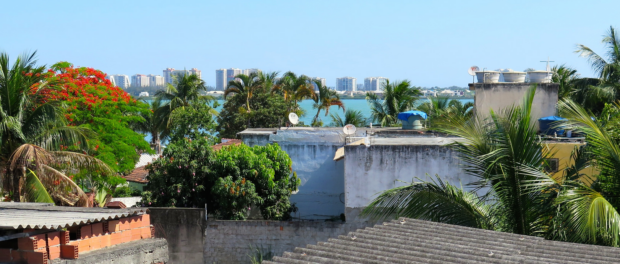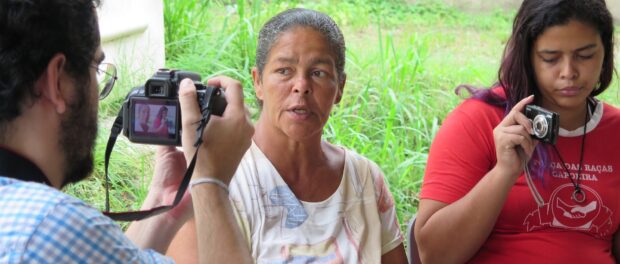
Sunday, August 5 marks the second anniversary of the Rio 2016 Olympic Games. This is the second article in a six-part series that comprises the book chapter entitled “Not Everyone Has a Price: How the Small Favela of Vila Autódromo’s Fight Opened a Path to Olympic Resistance” recounting the story of Vila Autódromo’s struggle. Written by Theresa Williamson, executive director of Catalytic Communities,* the chapter is part of the book ‘Rio 2016: Olympic Myths, Hard Realities‘ edited by economist Andrew Zimbalist. To read our review of ‘Rio 2016,’ click here. RioOnWatch would like to thank Brookings Press for providing the permission to republish the chapter here in its entirety.
It is in this complex context (see Part 1) that the inspiring and rich story of the small, punch-above-their-weight favela of Vila Autódromo unfolds. As with virtually all favelas, the community ties its founding to a subsistence or employment opportunity, in this case one that was generated on the shores of the Jacarepaguá Lagoon. Settled by fishermen in 1967, fifty years ago, the small favela around eight kilometers southwest of City of God began just one year after the founding of its (in)famous regional compatriot (City of God is perhaps the prime example of a favela made famous over sensationalized violence with the 2002 film by the same name). But whereas City of God was settled initially as public housing—hours from the employment hubs of the time, filled with military regime evictees globbed together against their will despite originating in different communities—Vila Autódromo was settled by a small group of fishermen choosing the location for their subsistence and to settle,1 unconcerned with the lack of development in the region at the time. In fact, the entire region was characterized by what were seen by many as impenetrable wetlands.
 In 1971, workers came to the area to build the Nelson Piquet International Autodrome, Rio de Janeiro’s Formula One racetrack, which would occupy the bulk of the peninsula on which Vila Autódromo was located. This is when the small community took its name, Vila Autódromo, or “Racetrack Village,” as those workers joined the original fishermen in expanding the community’s footprint. Again, the favela expanded around employment, as is typically the case.
In 1971, workers came to the area to build the Nelson Piquet International Autodrome, Rio de Janeiro’s Formula One racetrack, which would occupy the bulk of the peninsula on which Vila Autódromo was located. This is when the small community took its name, Vila Autódromo, or “Racetrack Village,” as those workers joined the original fishermen in expanding the community’s footprint. Again, the favela expanded around employment, as is typically the case.
Over the subsequent decades Vila Autódromo consolidated itself into a favela of some 700 families, filling all the potential lots available between the lagoon on one side, the racetrack on a second side, and a canal on the third. Original settlers eventually sold what were considerably large favela lots, allowing for some homes, decades later, to occupy 400 square meters of land on the edge of the lagoon or within what became the core area of the favela, nearer the Ambassador Abelardo Bueno Avenue. In some cases, large lots allowed families to grow, from one small home to two or three on the same compound, with several generations of a single family benefitting from their individual homes located on a family compound with trees and space allowing for an active outdoor private family life within the compound. Others grew their houses into quite large individual homes. Some used the outdoor space to plant fruit trees, open mechanic repair shops for Formula One cars, or establish Candomblé terreiros for Afro-Brazilian spiritual rituals requiring intense relationships with the land. Still others opened businesses in front of or below their homes, and churches were established, both Catholic and evangelical. Eventually, many also subdivided their plots, so the community also hosted a number of small, more precarious dwellings of those who moved in more recently and were beginning the process of iterative development that characterizes favela consolidation and informal development. Meanwhile, a small subset of fishermen continued living on and off the water throughout the decades.
Some twenty-five years after it was founded, in the early 1990s, Vila Autódromo faced its first battle against eviction. This was when the up-and-coming neighboring area of Barra da Tijuca began expanding into the wetlands nearby. Barra da Tijuca was a response of real estate developers to high levels of crime in the wealthy South Zone of the city and redemocratization after the fall of the military regime: the whole region developed since the 1980s as thousands of gated community condominiums that were packaged for exclusivity and exclusion. The pretext for eviction at the time was environmental. Rio would host the UN Earth Summit, the UNCED (United Nations Conference on Environment and Development), in 1992 and the city administration used this as justification for removing the favela, which it said posed a visual and environmental threat to the area.
Residents organized, however, via their highly active Vila Autódromo Residents, Fishermen, and Friends’ Association (Associação de Moradores, Pescadores e Amigos da Vila Autódromo, or AMPAVA). The recent adverse possession clause in the federal constitution,[a] combined with Rio state’s own 1989 constitution’s similar determination that land must fulfill a social function, were key to the community’s victory. They worked with public defenders and, in the early 1990s, were able to secure two leases from Rio governors. Termed Concessão de Direito Real de Uso, these “real use concessions” were provided by the state government because the peninsula on which Vila Autódromo sat was state-owned land. The more robust concession, delivered in 1998, provided occupancy rights for ninety-nine years, with the right to renewal for another ninety-nine.
Vila Autódromo then continued its self-styled development for another two decades, further consolidating itself with each passing year, residents being well employed given the labor opportunities associated with the Barra da Tijuca region’s boom over this period. During this period, the community also fought for public investment in sewerage infrastructure, road paving, and other upgrades. But at no point did the city government invest there, even despite the community’s now-official status. The only investment made by a public official was when a political candidate running for office provided resources for a small playground in an attempt to attract votes. The poor-quality equipment was thereafter maintained by residents.
One date stands out in Vila Autódromo’s story like no other. On October 2, 2009, the International Olympic Committee (IOC) voted on which city would win the bid to host the 2016 Summer Olympic Games. Rio, unlike Chicago, had suffered no public protest in response to the bid, and along with other elements of planning and projection that had been “fixed” in relation to its three earlier bids, appeared a solid choice. In Rio’s traditional wealthy South Zone, a state-sponsored celebration had been organized on Copacabana beach with 100,000 in attendance. When Rio was declared ‘winner,’ the crowd erupted in elated joy in a way that only a party city marked by three decades of stagnation and finally getting a glimpse of life postlimbo could experience. The excitement and hope was palpable across the city.
Meanwhile, Vila Autódromo artisan and director of the residents’ association, Jane Nascimento, was dozing off later that night in front of her television. In a drowsy haze she heard a press conference taking place. Rio de Janeiro Mayor Eduardo Paes, elected just a year prior, was responding to questions about Rio’s successful bid. In one of his responses, he announced that Vila Autódromo would be “the only community removed” for the Olympic Games.[b]
Nascimento had fought eviction threats before. In addition to the threats of the early 1990s, Vila Autódromo had also resisted eviction in the lead-up to the 2007 Pan American Games nearby. The mayor’s announcement shook her to her core, and once again, Nascimento, together with Altair Guimarães—the popularly elected president of AMPAVA—other directors, and dedicated community members from across the favela, began organizing, starting by reaching out to the state’s public defenders’ office, for legal protection.
Click here for Part 3.
This is the second article in a six-part series that comprises the chapter entitled “Not Everyone Has a Price: How the Small Favela of Vila Autódromo’s Fight Opened a Path to Olympic Resistance” recounting the story of Vila Autódromo’s struggle. The chapter is part of the book ‘Rio 2016: Olympic Myths, Hard Realities.’ RioOnWatch would like to thank Brookings Press for providing the permission to republish the chapter here in its entirety.
Notes
[a] Adverse possession refers to when one occupies an area for a given period without contest and is thus permitted to file to acquire the land. The Brazilian constitution stipulates this at five years in urban areas, for up to 250 square meters. Adverse possession originated in England in the 17th century.
[b] Yet, behind the scenes Paes’s administration had already been setting the public stage for the relaunch of 1960s-era eviction policies, working to remove what he labeled “the taboo” on favela evictions. On April 12, 2009, just three months into his administration, Rio’s most influential and largest newspaper, O Globo, firmly associated with Rio’s right wing since the military regime, published the final of several articles, this one on its front page, declaring, “Since the 1980s, favela evictions were stigmatized as an authoritarian practice of the past,” thus heralding the return of an evictions policy. Torrential rains on previous days had led to a number of landslides in favelas, which were used as a pretext for this campaign.
Additional Bibliographic References
[1] Juliana Barbassa, Dancing with the Devil in the City of God (New York: Touchstone, 2015), p. 220.
Complete Series: Not Everyone Has a Price: The Story of Vila Autódromo’s Olympic Struggle
Part 1: (Re)Introducing Favelas
Part 2: Introducing Vila Autódromo
Part 3: Vila Autódromo’s Rise as a Symbol of Olympic Resistance (2010-2012) [VIDEO]
Part 4: Intimidation and the Critical Turning Point (2013-2014) [VIDEO]
Part 5: The City Proceeds with Eminent Domain and Violence (2014-2016) [VIDEO]
Part 6: Conclusion—Vila Autódromo in the Context of Rio’s Olympic Evictions
Also see: Timeline of Vila Autodromo
*RioOnWatch is a project of the NGO Catalytic Communities




